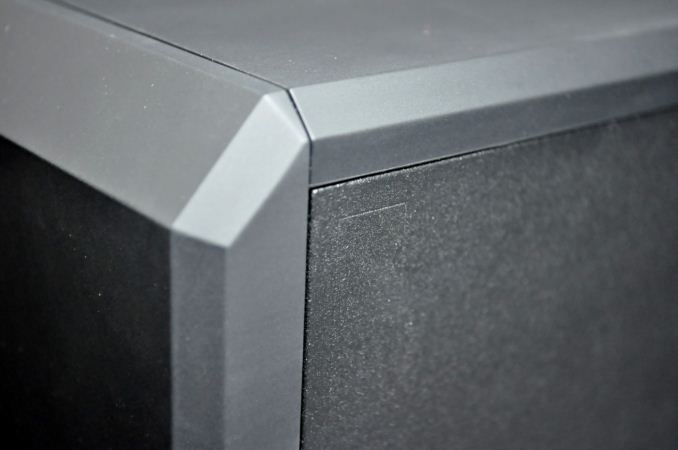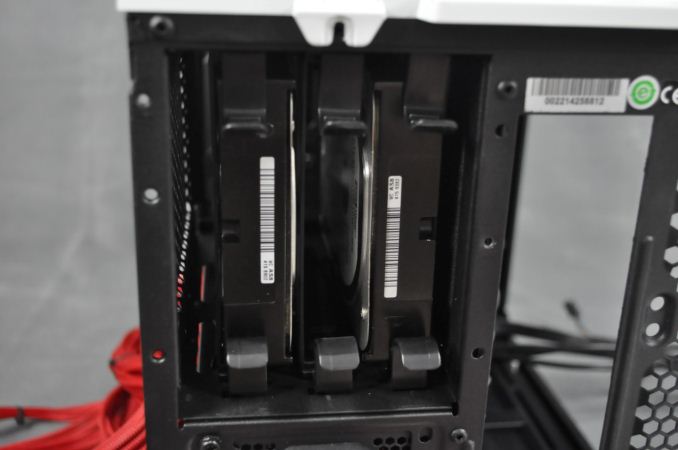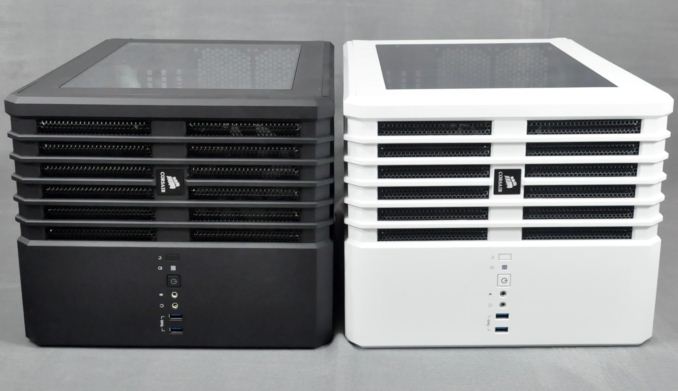Corsair Carbide Air 240 Case Review
by E. Fylladitakis on August 15, 2014 6:00 AM EST- Posted in
- Cases/Cooling/PSUs
- Corsair
- ATX
- Case
- Carbide
Corsair Carbide Air 240 Exterior
"And we shall call it…mini-540". This is what Corsair must have been thinking while designing their latest addition to the Carbide series, the Air 240. The new Micro-ATX case looks exactly like an undersized version of the Carbide Air 540 that we reviewed a little over a year ago. With a size of 315mm × 265mm × 400mm (H×W×D) and a total volume of 0.0334m3, the Carbide Air 240 is not a very compact Micro-ATX case, yet it takes less than half the volume of the Air 540 (61.55% less) and less volume than the Obsidian 350D (21.87% less). It also adds Micro-ATX compatibility over the Obsidian 250D for just 16.9% more volume.
Corsair currently offers the Carbide Air 240 in two colors, black and white, both of which are depicted in the following galleries. It is interesting to note that the metallic parts of the black version have been sprayed with a grainy, satin black paint, while a smooth matte black paint covers the plastic parts. The difference in the paint on the black isn't a major deal, but it is apparent when performing a close inspection. The white version on the other hand is immaculate, with the entire exterior having being sprayed with a satin white color.
Aesthetically, the Carbide Air 240 sports an interesting asymmetric design that hints at the internal dual-chamber configuration. The left part of the faceplate is vented, as is the left part of the top and bottom panels as well, creating exceptional cooling possibilities for the main system. We can see the I/O ports and buttons on the right middle side of the faceplate, with the company logo in alignment towards the left side of the case. The left side panel is almost entirely covered by a transparent acrylic window, revealing the entire main system to the spectator.
The top and bottom panels of the Carbide Air 240 are secured with two thumbscrews each. By removing these thumbscrews, both panels easily slide off. However, as the case actually sits on the bottom panel, it will have to be placed on its side or upside down before removing it. The removal of either panel reveals the frame for the installation of 120mm fans and/or liquid cooling radiators.
It is very interesting that Corsair went with a "rails" design, allowing the user to adjust the location of the fans/radiator by a few centimeters towards the front or the rear of the case. Each of the side panels is secured with two thumbscrews each as well, but these thumbscrews are partially threaded and do not come off the panel when removing it. The front panel can also be removed, but the user needs to first remove both side panels and undo the plastic clips that hold the front panel in place.
Even though the right side panel of the Carbide Air 240 will have to be removed before the user can wire any of the drives, both drive cages are accessible from the exterior of the case. The 2.5" drive cage is beneath the top panel, which has to be removed in order to gain access to it. The 3.5" drive cage is accessible from the rear of the case, by removing a perforated metallic cover held in place with a single thumbscrew. The plastic trays of the 3.5" cage can hold 2.5" drives as well. Strangely, even though the plastic trays have been inserted facing rightwards from the factory, they need to be installed facing leftwards in order to fit three full-size 3.5" mechanical disks.
It is also possible to use the Carbide Air 240 sideways and there are even slots on the metallic right side panel for the rubber feet that Corsair provides in the bundle. However, that will also rotate the faceplate and everything printed on it, including the I/O legend and the case badge, making the Carbide Air 240 look rather odd and off-place. The case badge is magnetic and may be rotated, but that is not true for the I/O legend and buttons.



























63 Comments
View All Comments
darkbreeze - Friday, November 14, 2014 - link
The biggest problem with this case has nothing to do with the drive or lack therof. Seems no decent GPU cards will fit due to card HEIGHT not length. Even the ones made for mini-ITX enclosures don't fit as seen here:http://www.tomshardware.co.uk/answers/id-2363784/a...
Zak - Wednesday, April 15, 2015 - link
I want this case for a gaming-only build that will only have couple of SSDs in it so I'm happy with the absence of 5.25" bays. I had 540 and it was too large with tons of wasted space and was taking up too much floor space so I went back to a regular tower for that build.RealAntithesis - Tuesday, March 13, 2018 - link
A few years after the date of this article, but hey: I built a Ryzen system using this case. Main reason I chose the case was its looks and small footprint. However, some issues I've come across that people should consider when buying:1. As mentioned in the article, there is no room for a second dual slot video card at the bottom of the case - some matx motherboards have a 16x slot at the bottom, but the Air 240 can't accommodate one without some case modification work due to lack of a fifth expansion bay. A 2nd video card could fit in the in the third expansion slot though (assuming the motherboard has a 16x pcie slot here).
2. Also as mentioned in the article, air coolers are limited due to the height restrictions. However, the noctua c14s does fit, but only in its single fan configuration placing the fan close to the motherboard. I also rotated the heat sink 180 degrees to avoid getting too close to the ram sticks. The c14s takes up a large chunk of the horizontal area of the side panel window, but gives decent cooling performance (and it fits, albeit fairly tightly with surrounding components).
3. The side window is made of plastic. Due to the lack of clearance, the 6 and 8 pin power cables from my 1080ti have squeezed up against the window. Unfortunately, with the video card routinely getting to 80C (it's hot over here, and that's running at 60% power limit), the plastic window now has little grooves where the wires from the power cable were touching, presumably from the heat. Obviously, I need to work on temps, but the side window should be made out of tempered glass like some others are.
4. The case panels are made out of plastic, including the bars covering the fan vents on the top. While this probably reduces weight, this unfortunately means it's not very strong. It's quite easy to press slightly on the panel, causing it to bend and causing the spinning fan on the other side to hit something, maybe the grill (I'm not sure, but I wasn't about to do that again if I could help it).
5. The metal grill and / or the plastic between the top fan and plastic panel tends to vibrate with the fan, resulting in a very audible and annoying hum or buzzing noise. Then I have to press in various places to touch the sweet spot to quieten it down again. It's quite annoying.
6. That's it. Apart from all the above, it's otherwise a decent case, but I'm thinking of switching it out for another.